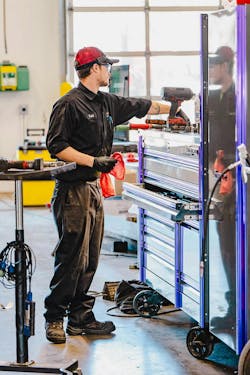Key Highlights
- Shops tackle plenty of tough, dirty jobs, which can mean shops themselves get dirty. But maintaining shop cleanliness offers a lot of benefits in terms of employee well-being and shop reputation
- To help keep your shop clean, there are plenty of products and processes to help keep things organized, from floor sweepers and stain removers to spill kits and tool organizers
- Additionally, shops can leverage the 5S lean strategy to maintain cleanliness, locker systems, and peg-board systems to help techs find what they need
There’s no way to avoid it. Vehicle repair shops get streaks, stains, and smudges on the floors, walls, toolboxes, and pretty much everywhere.
That’s because for all the technology and circuits modern trucks have, engines, chassis, wheel-ends, and more still require grease and oil to lubricate their moving parts. And the threaded fasteners holding everything together? Those get brushed with grease, too. Then there are all the coolants and other fluids that leak from certain trucks rolling into the bay.
Over time, these little blemishes and spills build up. On the floor, the obvious danger is a technician running afoul of an oil slick and hitting the deck, but your reputation with customers could also take a tumble if you don’t take your shop’s appearance seriously.
“If you have a clean, crisp, pristine environment that shines and makes you proud, you feel better if you have associates in it,” explained Steve Wilson, CEO of Valentine Performance Detailing. “If you’re a commercial operation, it makes everyone feel better, and makes your customers believe you care about the detail.”
Craig Probst, president of Hendrickson Fire Equipment, a dealership in Islandia, New York, agreed.
“[Customers] take a lot of pride in their equipment,” Probst said. “They want to know that their vehicles are being serviced and cared for in a dealership that values quality.”
There are several studies that show the link between clean work environments and employee productivity, such as a 2016 Staples survey where 94% of respondents said they felt more productive in a clean work space.
Probst also noted a main reason a lot of effort is put into cleaning and organizing the shop is to make a good impression on prospective new hires.
“They want to come work here because it’s different than a lot of other shops,” Probst stated. “It’s really clean and organized, and it’s something that they tell us is pretty unusual.”
With the right attitude and solvents, a little elbow grease, and a steady supply of discipline, any shop can clean up its act. Here are some strategies and products your shop can use.
Shop floors
The way to make the biggest impact is focusing on the biggest surface area: the floor.
“No one can argue that a nice, shiny, clean floor is a great thing,” noted Wilson, who spent much of his career managing high-end hotels before switching to automotive and garage products. “It builds pride as well, and pride will translate into performance and customer service and all the other things we strive for.”
To get that impressive shine, Valentine offers Garage Gloss, a polymer-based floor finish that gives floors that racing-shop sheen. He recommends four or five coats, which each take about an hour to dry, but some customers go up to nine.
Before you apply that, your floor has to be clean so you don’t seal in stains. Neutral cleaners and powders should be applied regularly to prevent a buildup of dirt.
“We have the expectation that whenever a truck comes in, when we pull that truck out, that bay gets cleaned,” said Doug Conniff, Rihm’s south regional service operations manager. If grime builds up while six trucks move in and out of a bay, “It’s not professional, it’s not safe, and it’s not efficient,” he added.
Rihm uses Tennant Company floor sweepers for newer locations. For older bays, they dry sweep and follow with a power washer.
For set-in oil and grease stains, you could try Oil Eater Overnight Stain Remover. It contains microbes that eat away at the stains beneath asphalt or concrete. After applying the liquid, wait six to 12 hours and sweep away the remains. We tested it at Beaulieu Auto Center, based in Cleveland, Ohio, and found on larger set in stains, more than one application may be needed.
To make cleaning easier, always attack oil and other spills posthaste. For one, it keeps oil from seeping into porous concrete. Safety is the main priority, though, which is why Rihm Kenworth preaches immediate action.
“We don’t need people slipping and being out of the shop,” Conniff said.
Several suppliers carry emergency spill kits containing sorbent rolls, socks, and pillows to corral runaway oil. When deciding what kind of spill kit to have handy, some math is required. If you have 55-gallon drums, make sure what you have on hand can handle the whole drum tipping over.
“If it’s a big spill out there, our first goal is to keep it from spreading out any further than what it is,” Conniff commented.
To do this, shops can use spill kits like SpillTech’s Universal 65-Gallon OverPack Salvage Drum kit or Andax Industries’ Big Containment Pac, which come with absorbent socks and, in Andax’s case, a pop-up containment pool.
For smaller accidents, Conniff explained that they’ll put down absorbent pads to pick up as much liquid as possible. Then, they’ll come back later and spread granular absorbents over the spill, or use a sweeper if absorbents aren’t needed.
Wilson noted while some spill kits contain clay absorbents, Valentine prefers coconut coir in its FlashDry Rapid Response Spill Kit. “It’s an amazing absorbent, five to seven times more absorbent than clay-based products that are on the market,” he said, adding it picks up gas, diesel, and even jet fuel. He said a 50-liter bag has the same absorbing power as a 40-lb. bag of its clay counterpart.
Tool and toolbox care
Clean technician workstations also go a long way in instilling trust in customers and co-workers. This extends from tool storage and worktops to the tools themselves, as even the most robust tools will wither if not maintained.
“The truth is that nothing’s indestructible, so if you’re not taking care of your tools, you will start to see things like corrosion, depending on your environment,” said Colin Speer, director of sales at Sonic Tools.
Fortunately, taking care of tools is easier than oily floors.
When Conniff was a tech, he’d wipe down his tools before putting them back after every job. And Speer said that most cleaners and degreasers applied to a rag or paper towel will do the trick.
“If you were in a more caustic environment, you might want to add a little drop of oil,” Speer noted.
Marshall Sheldon, a mobile tech at MHC Kenworth, said brake cleaner is also a good option. He added that in the field, soap and water will promote rusting on metal tools.
Wipes such as Apex’s Heavy Duty Cleaning Wipes and Tub O’ Towels’ Heavy Duty Dual Texture Wipes also work for tools, surfaces, and technicians’ hands.
As for toolboxes, be sure to wipe down or vacuum out your box on occasion, Speer advised. If you use a foam system to organize your tools, this might not be as necessary.
Foam will help you keep drawers tidy and every tool in its place, but they are not all the same. Open-cell foam, which tends to have a pool-noodle consistency, collects more debris and oil that may deteriorate the material. Speers said closed-cell formulation, which Sonic uses in its Foam System, is more durable and easier to clean.
“It’s very, very dense,” Speer noted. “It does not collect any of that foreign debris or oil, so it can be wiped down.”
Organizing tools and equipment
Along with making toolboxes easier to clean, foam systems help protect tools and make it easy to spot what you need, improving productivity.
“The longer you spend looking for stuff that you didn’t put back where you’re supposed to, is time wasted,” Rihm’s Conniff affirmed.
On a formal level, foam systems can be part of the 5S lean strategy, a workplace organization method that stands for ‘Sort,’ ‘Set in order,’ ‘Shine,’ ‘Standardize,’ and ‘Sustain.’
Probst said at Hendrickson, the goal has been to make 5S “part of our culture and part of everyone’s habits on a daily basis.”
This helps keep track of tools, parts, and materials. Hendrickson uses an automated locker system to check communal tools in and out, which fulfills the shop’s ‘Set in order’ principle.
“When we talk about the 5S system, [the lockers] check a lot of the boxes there,” Probst affirmed. “All these tools have a set place where they belong. They’re not just random shop tools put on a shelf or left on someone’s toolbox.”
But shops have plenty of options for organizing their shared tools. For instance, at Taylor & Lloyd, Missy Albin, senior lead master technician and International Trucks ambassador, noted that her shop uses a reinforced peg-board system to store tools. The tools are separated per engine, and items in a tool kit are stored on shelves and organized by color, with S13 engine kits marked with purple, Eaton boxes with blue, and coolant in red.
“I always recommend this system, because it gets everything off the floor,” Albin said.
Alternatively, Conniff said he’d seen some Rihm shops paint tool locations on the floor and walls. And in the future, “I can foresee us having a mapped directory in the store,” he added.
About the Author

Alex Keenan
Alex Keenan is an Associate Editor for Fleet Maintenance magazine. She has written on a variety of topics for the past several years and recently joined the transportation industry, reviewing content covering technician challenges and breaking industry news. She holds a bachelor's degree in English from Colorado State University in Fort Collins, Colorado.

